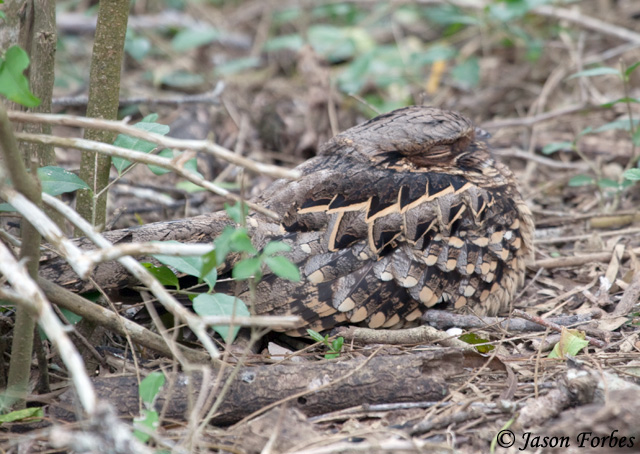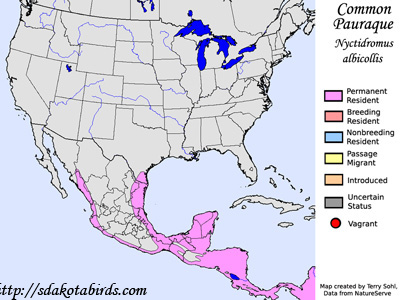| Length: 11 inches | Wingspan: 24 inches | Seasonality: Non-resident in South Dakota |
| ID Keys: Distinct brown cheeks, tan to rufous edges on scapulars, "gray morph" mostly gray while "rufous morph" has significant rufous on chest and tail, long tail | ||
 The
Common Pauraque is a common nightjar species of the tropics, with a range
that extends from South America all the way northward to southern Texas.
Although they overlap in range with some other nightjar species, the Common
Pauraque is typically the most common, low-elevation nightjar in much of its
range. They can be very difficult to observe during the day, as their
plumage provides very good camouflage against the forest leaf litter where
they often rest. At night, they are most often seen when flying, when
their white wing bar flashes conspicuously.
The
Common Pauraque is a common nightjar species of the tropics, with a range
that extends from South America all the way northward to southern Texas.
Although they overlap in range with some other nightjar species, the Common
Pauraque is typically the most common, low-elevation nightjar in much of its
range. They can be very difficult to observe during the day, as their
plumage provides very good camouflage against the forest leaf litter where
they often rest. At night, they are most often seen when flying, when
their white wing bar flashes conspicuously.
Habitat: Found in open woodlands and areas of dense brush in the small U.S. portion of their range. When foraging, uses woodland edges and more open habitat.
Diet: Feeds on insects, with many beetles consumed, as well as moths and other insects that emerge at night.
Behavior: Does much of its foraging by sitting still on a branch or on the ground, looking for passing flying insects, and fluttering up to grab them when they come into range. They will also sometimes forage while in flight, or grab insects on the ground.
Nesting: The Common Pauraque doesn't build a formal nest. The female lays 2 eggs directly on the ground, usually near the base of a shrub or other vegetation, on top of litter or other vegetative material. Both the male and female help to incubate the eggs. When the eggs hatch, both parents feed the young through the regurgitation of insects.
Song: The song of a Common Pauraque is a crisp buzzing series of whistled notes with significant changes in pitch and volume. They also have a call of multiple notes that slowly builds in volume.
Migration: Considered a permanent resident throughout their normal range.
Interactive eBird Map: Click here to access an interactive eBird map of Common Pauraque sightings
Similar Species: In range, most likely to be confused with Chuck-will's-widow or Whip-poor-will.
Conservation Status: Populations may be in decline, but they are still found over a wide geographic region and are relatively common in some locations. The IUCN lists the Common Pauraque as a species of "Least Concern".
Further Information: 1) Texas Breeding Bird Atlas - Common Pauraque
2) Audubon Guide - Common Pauraque
3) Cornell's Neotropical Birds - Common Pauraque
Photo Information: Photo taken by Jason Forbes - February 10th, 2010 - Progreso, Texas - Photo licensed under Creative Commons Attribution NonCommercial NoDerivs 2.0 Generic License.
| Click below for a higher-resolution map |
 |
| South Dakota Status: Non-resident in South Dakota |
Additional Common Pauraque Photos (coming soon!!)
